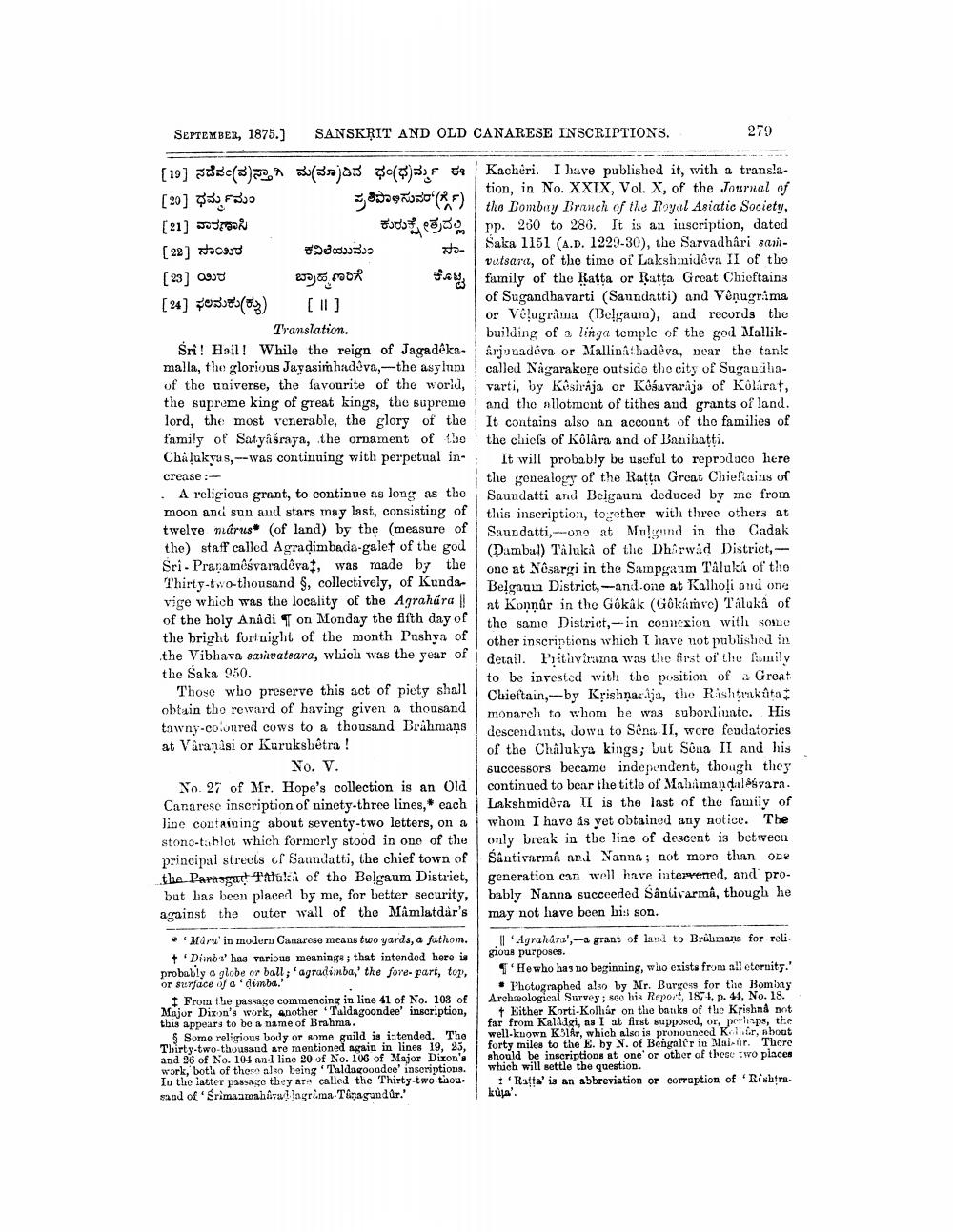________________
SEPTEMBER, 1875.]
[10] ನಡೆ(ನಾ ಮುಳಗಿದ ಭಂಭ್ರಮ ಈ [20]
(F)
[21] ವಾರಣಾಸಿ
[22] ಸಾಯಿರ
[23]
[24] ಫಲಮಕು(ಕು)
SANSKRIT AND OLD CANARESE INSCRIPTIONS.
ಕವಿಲೆಯುಮಂ
ಬ್ರಹ್ಮ ರಿಗೆ [U]
ato
Translation.
Śri! Hail! While the reign of Jagadékamalla, the glorious Jayasimhadeva,-the asylum of the universe, the favourite of the world, the supreme king of great kings, the supreme lord, the most venerable, the glory of the family of Satyasraya, the ornament of the Chalukyas,--was continuing with perpetual in
crease :
A religious grant, to continue as long as the moon and sun and stars may last, consisting of twelve márus (of land) by the (measure of the) staff called Agraḍimbada-galet of the god Sri Pranamêsvaradêvat, was made by the Thirty-two-thousand §, collectively, of Kunda vige which was the locality of the Agrahara of the holy Anâdi T on Monday the fifth day of the bright fortnight of the month Pushya of the Vibhava samvatsara, which was the year of the Saka 950.
Those who preserve this act of piety shall obtain the reward of having given a thousand tawny-coloured cows to a thousand Brahmans at Varanasi or Kurukshetra !
No. V.
No. 27 of Mr. Hope's collection is an Old Canarese inscription of ninety-three lines, each line containing about seventy-two letters, on a stone-tablet which formerly stood in one of the principal strects cf Saundatti, the chief town of the Parasgar Taluka of the Belgaum District, but has been placed by me, for better security, against the outer wall of the Mâmlatdar's
* Maru' in modern Canarese means two yards, a fathom. Dimba' has various meanings; that intended here is probably a globe or ball; 'agradimba,' the fore-part, top, or surface of a 'dimba.'"
From the passage commencing in line 41 of No. 103 of Major Dixon's work, another Taldagoondee' inscription, this appears to be a name of Brahma.
§ Some religious body or some guild is intended. The Thirty-two-thousand are mentioned again in lines 19, 25, and 26 of No. 101 and line 20 of No. 106 of Major Dixon's work, both of there also being 'Taldagoondee' inscriptions. In the latter passage they are called the Thirty-two-thou sand of Srimaamahiva lagrima-Tunagundur."
279
Kacheri. I have published it, with a translation, in No. XXIX, Vol. X, of the Journal of the Bombay Branch of the Royal Asiatic Society, pp. 260 to 286. It is an inscription, dated Saka 1151 (A.D. 1229-30), the Sarvadhâri samvutsara, of the time of Lakshmidêva II of the family of the Ratta or Ratta Great Chieftains of Sugandhavarti (Saundatti) and Vênugrima or Velugrama (Belgaum), and records the building of a linga temple of the god Mallikarjunadeva or Mallinathadeva, near the tank called Nagarakere outside the city of Sugandhavarti, by Kêsiraja or Kôáuvaraja of Kôlarat, and the allotment of tithes and grants of land. It contains also an account of the families of the chiefs of Kôlara and of Banihaṭṭi.
It will probably be useful to reproduce here the genealogy of the Ratta Great Chieftains of Saundatti and Belgaum deduced by me from this inscription, together with three others at Saundatti,-one at Mulgund in the Cadak (Dambal) Taluka of the Dharwad District,one at Nêsargi in the Sampgaum Tâluka of the Belgaum District,-and-one at Kalholi and one at Konnûr in the Gôkâk (Gôkámve) Taluk of the same District,-in connexion with some other inscriptions which I have not published in detail. Prithvirama was the first of the family to be invested with the position of a Great Chieftain,-by Krishnaraja, the Rashtrakuta monarch to whom he was subordinate. His descendants, down to Sêna II, were feudatories of the Chalukya kings; but Sona II and his successors became independent, though they continued to bear the title of Mahamandal svara. Lakshmidêva II is the last of the family of whom I have ás yet obtained any notice. The only break in the line of descent is between. Sântivarmâ and Nanna; not more than one generation can well have intervened, and probably Nanna succeeded Sântivarmâ, though he may not have been his son.
Agrahara',-a grant of land to Brühmans for religious purposes.
He who has no beginning, who exists from all eternity." Photographed also by Mr. Burgess for the Bombay Archaeological Survey; seo his Report, 1874, p. 44, No. 18.
Either Korti-Kollár on the banks of the Krishna not far from Kaladgi, as I at first supposed, or, perhaps, the well-known KS1Ar, which also is pronounced Keilir, about forty miles to the E. by N. of Bengalêr in Mai-ur. There should be inscriptions at one' or other of these two places which will settle the question.
Ratta' is an abbreviation or corruption of Rishtra
kuja'.




